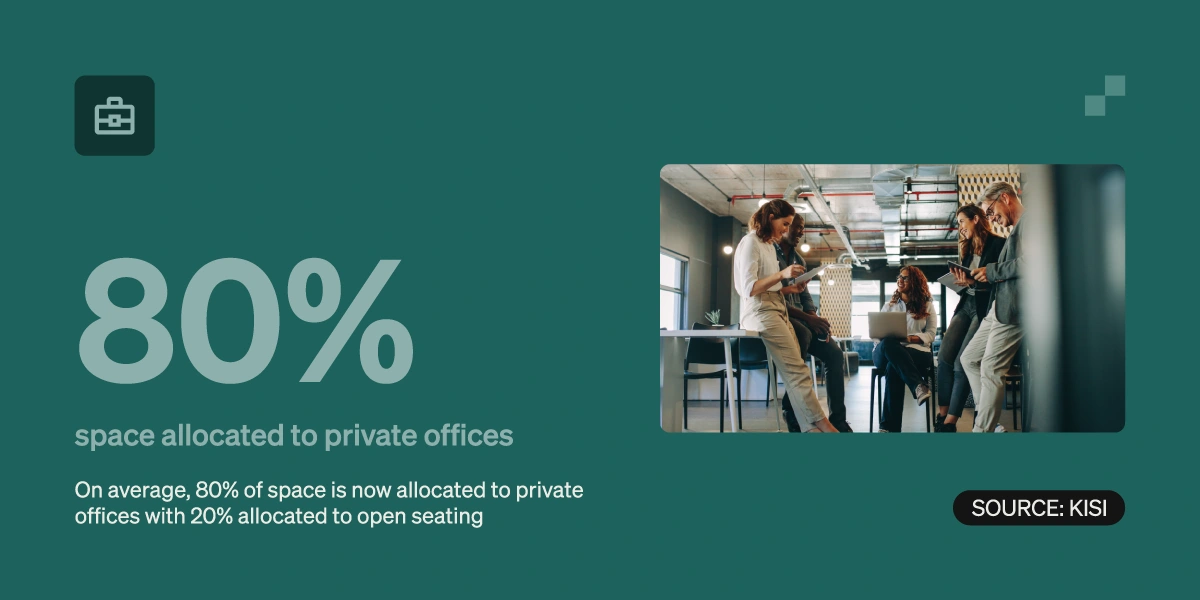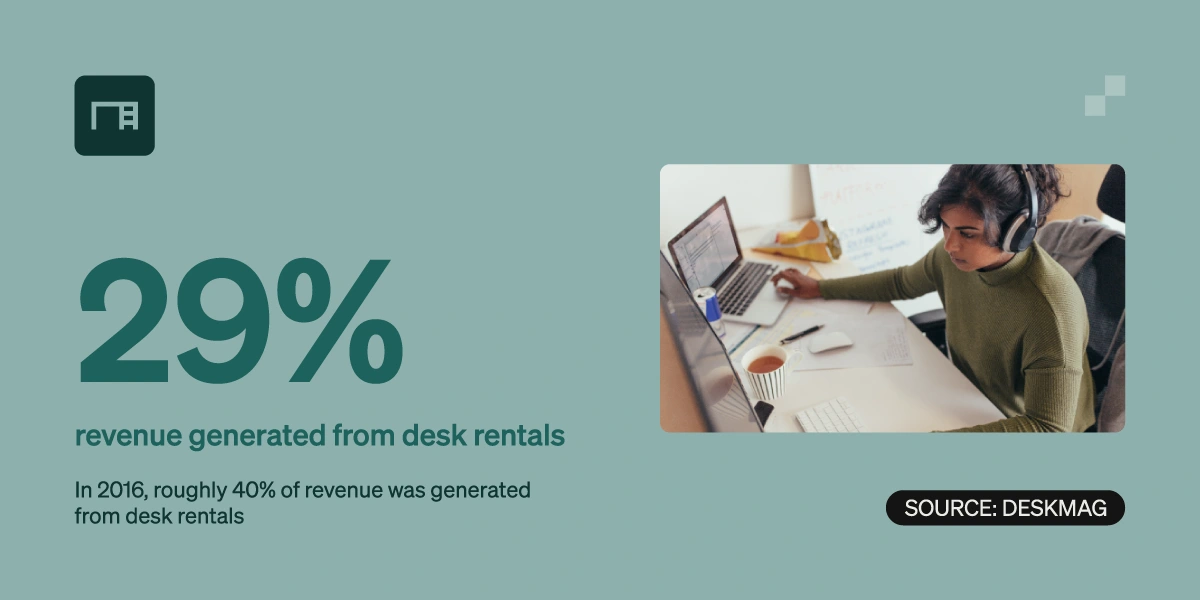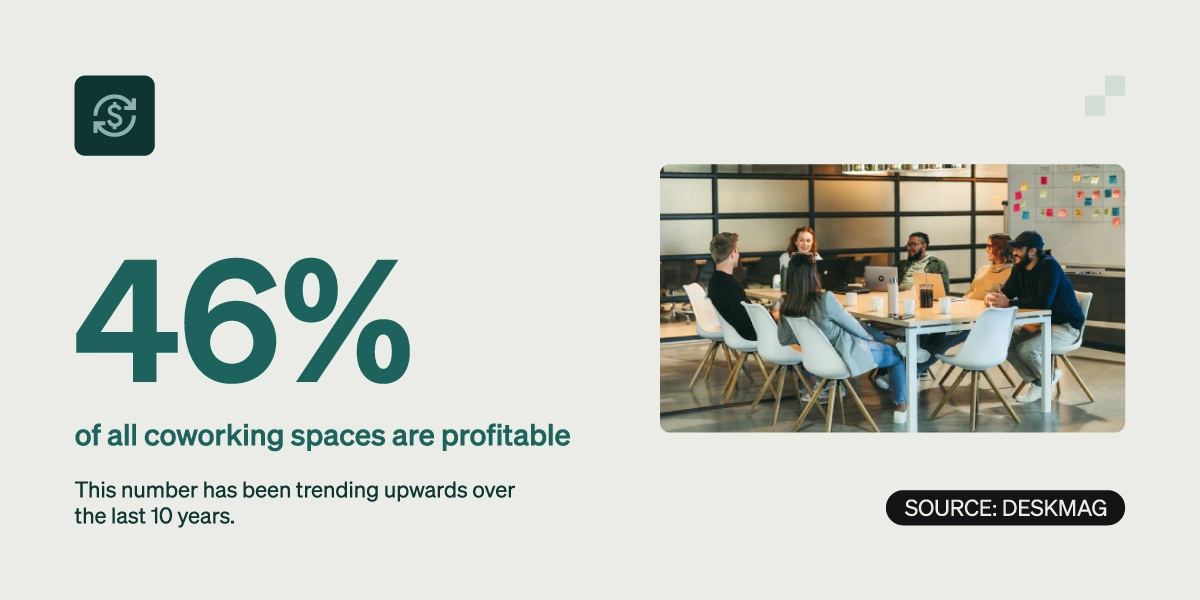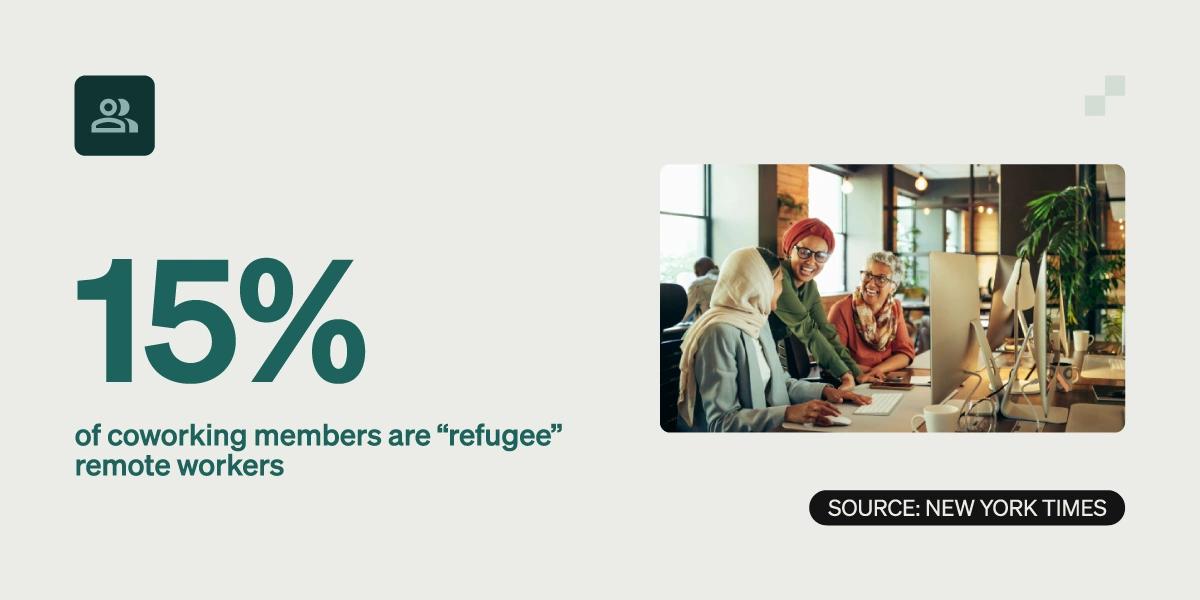- The coworking sector is (still) growing - but the rate varies
- Goodbye hot desks, hello private offices
- Alternative revenue streams as the revenue streams
- Profitability will (continue to) improve
- Hospitality and experience finally take center stage
- Corporate clients become big business for coworking
- Automation will be the secret to successful spaces
- Co-everything is here to stay
- Suburban and small-town coworking is booming
Every year, the Optix team sits down to write a trends article. And for the past three years, we’ve seen near identical trend lists.
Now why is that? Why is it that we are still talking about private offices, niche coworking spaces, and suburban coworking?
Part of it is because it takes a long time for things to change. The other part is because although some of these were trends in 2023 (looking at you, niches), the trend is deepening, widening and continuing to shift the industry in significant ways.
In this year’s article, we’ll talk about the trends we’re seeing with updated numbers for 2025 including the growth of suburban coworking, targeting corporate clients in coworking spaces, the rise of private offices, and more.
1. The coworking sector is (still) growing – but the rate varies
Coworking was, is, and has been growing rapidly post-COVID, but that rate seems to vary depending on where in the world you’re located.
The now infamous JLL prediction that 30% of office space will be flex by 2030 is probably not entirely true according to more recent data from The Instant Group. They predict a far more conservative 5% based on updated research.
This number fluctuates however. At a Coworking Canada Unconference talk by Stirling Bell of Pavilion, he shared that roughly 2% of global real estate is currently flex. In certain cities like London, it could be as high as 10%. In North America, that number could be less.
All this to say, the future of coworking looks promising (though we may be biased). But with growth comes competition, particularly as big players enter markets that indie operators have traditionally dominated.
One study out of the UK found that the entrance of larger coworking entities into local markets could present challenges for smaller operators. The research argues that when large coworking companies or actors enter the sector, they force smaller operators to alter their offering to stay competitive.
As an independent operator, think about how you can differentiate yourself from the big guys by delivering an exceptional, community-driven experience (more on this later).
Where do we think this trend is going?
We predict the coworking sector will continue to grow – and actually accelerate over the next 2-4 years as more long-term leases expire and commercial real estate looks to optimize their space utilization.
2. Goodbye hot desks, hello private offices
When looking at the history of coworking, the original view was that coworking spaces would be primarily made up of open seating areas where individuals could freely interact and collaborate with one another.
So came the “hot desk”, an on-demand seating option designed for drop-in use. While hot desks are still a staple in most coworking spaces, demand for private offices has officially outpaced its open seating counterpart.
As reported by a number of operators, spaces are finding inconsistent success with open area seating, and more success with private and shared offices – private offices now take up around 80% of space allocation compared to 20% for open spaces.
Private offices have become so popular in fact, that many coworking consultants say you should be able to pay your rent in private office revenue alone.
Of course YMMV, but the consensus is clear – private offices are here to stay.
Where do we think this trend is going?
We think private offices are here to stay, too. The thing that operators will be figuring out in the coming years is how to host private offices without turning it into executive offices of the past. Community and privacy can coexist, operators just need to figure out how to make it happen in the modern workplace.
3. Alternative revenue streams as the revenue streams
With this change in product offering comes the emergence of alternative revenue streams as primary revenue streams. In 2016, desk rental and combined membership plans made up 56% of revenue on average. In 2023 they made up just 38%.
So how are operators making money? Well…with a lot of different things including:
- Phone booths, both private and semi-private
- Event space for after-hours events
- Alternative use space (ie. yoga rooms, podcast rooms, photo studios)
- Virtual mail programs
The last point is one coworking owners and operators couldn’t get enough of in 2024, and there’s no sign of slowing down. It seems like magic – set up a virtual mail system, invest limited resources in managing it, and collect a paycheque every month for doing next to nothing.
Of course, it’s not always that simple. But the numbers don’t lie – if you can crack the code on virtual mail, you can and will drive significant revenue for your business.
Others on the list, like event space or alternative use space, are more challenging to put into practice, but can be equally as lucrative. Class rentals and after-hour event rentals are highly in demand, and coworking operators are finding great success with the offering.
Where do we think this trend is going?
Virtual mail will become a standard in coworking, not unlike hot desk rentals of the past. Coworking spaces will step up to fill the need of mid-sized event space in the community, offering premium space at a better price than other alternatives. Operators will understand this and begin to design their spaces to hold large parties and events, along with workshops and classroom sized rooms, all in an effort to maximize space utilization.
4. Profitability will (continue to) improve
In 2023, roughly 46% of coworking spaces were profitable with the average profit margin being somewhere around 19.7%. Considering around 65% of small businesses across all industries are profitable, profitability is considerably more rare in the coworking sector.
According to research by DeskMag, as of 2023:
- 25% of coworking spaces failed to recoup their expenses (same as in 2019)
- 13% of coworking spaces are less than a year old (compared to 25% in 2019) – young coworking spaces are the least likely to be profitable
- The most profitable cohorts are those between 4 and 6 years old, 100 – 249 members, and 10,000 – 20,000 sq ft
If this feels grim however, we think it’s worth shifting your perspective.
The number of profitable coworking spaces has been trending upwards over the last 10 years. As the industry matures and operators gain knowledge of best practices and standard operating procedures for how to run a successful coworking space, we expect profitability to become more and more within reach for operators.
The demand for alternative work spaces is there. Now it’s up to the industry to level up how they run their operations so the profitability conversation can become a thing of the past.
Where do we think this trend is going?
A lack of resources and understanding is the number one reason why operators struggle with profitability. It’s not enough to just have a dream of opening a coworking space – you need to have a plan, too.
We think in a few short years, the profitability conversation will fade into the background. Operators will understand what it takes to run a successful business before they even open their doors, adding to the success of the individual spaces and the industry as a whole.
5. Hospitality and experience finally take center stage
As people look for more out of how they work, hospitality and experience will finally take center stage.
After speaking with coworking owners and operators around the world, it’s clear that hospitality and creating an exceptional member experience is becoming increasingly commonplace.
Your members can work from anywhere. They can work from their house, a coffee shop, maybe even a corporate office. For them to work from your coworking space, they have to want to work from your coworking space. And embracing hospitality is one of the best ways to get people to do just that.
“I think people need to understand that we are, in many ways, running hotels; we have desks not beds. You will need this hospitality mindset to achieve in this market. I believe this is going to become even more relevant over the next 5 years.”
Where do we think this trend is going?
Operators are finally going to start thinking about the service and experience that hotels provide and start modeling their space after them. That means star ratings, seamless purchasing and check-ins, and a service experience that is predictable, repeatable, and trustworthy.
6. Corporate clients become big business for coworking
For a long time, coworking attracted an audience of entrepreneurs, freelancers, digital nomads, and other solo workers. Now, it’s being made up more and more by remote workers and teams.
According to the New York Times, “refugee corporate employees”, ie. those who operate on a remote or hybrid work model, are a primary audience for coworking spaces worldwide. In 2023 they accounted for roughly 15% of all coworking members in some spaces.
Targeting remote workers can certainly help get more people in the door. But instead of acquiring a single remote employee, why not the whole organization?
Many operators are having huge success with targeting corporate clients and securing space for 5-20 of their employees to meet in a central location. It’s a win-win: corporations pay significantly less than they would for a large HQ, while coworking spaces benefit from a predictable paycheque every month.
If you want to try your hand at getting more corporate clients in your doors, try reaching out to remote businesses in your area and setting up a meeting to explain to them how coworking could benefit them and their employees. Offer a free tour or trial to really drive home the unique value of coworking.
Where do we think this trend is going?
Corporate clients are big opportunities for coworking spaces. As corporate entities gain more knowledge and understanding of coworking, the partnerships will become more and more commonplace. For now, it’s up to us to educate big business on the benefits of coworking and creating these partnerships together.
7. Automation will be the secret to successful spaces
Most coworking space owners and operators now have an understanding that technology is essential. What’s missing is the understanding of just how much technology can do.
In 2024, coworking software transformed into automation powerhouses, with Optix leading the charge. Now with coworking space automation software, operators don’t have to waste so much time completing manual tasks – they can use software to automate everything from member onboarding to lead management to bookings and invoicing, all from a single platform.
This frees up operators to spend more time doing the things that only humans can do – like connecting with members, face-to-face.
Operators like KWENCH are using automation and technology to save money and run more efficient businesses. We believe that the future of the coworking industry hinges on operators’ ability to be strategic and smart about their use of automation.
Where do we think this trend is going?
Right now, automation and coworking is in its infancy and it’s exciting. We see the automation capabilities of coworking technology expanding significantly as we rapidly move towards more automated, AI-driven workplaces. This will help operators spend more time doing the things they actually want to do (and less time doing the things they don’t).
8. Co-everything is here to stay
Over the last three years, we’ve seen the coworking niche space expand from co-warehousing and medical coworking to recording studios and beauty spaces.
Now, we’re seeing co-coffee roasters, co-dog washing, and so many other applications of sharing rented space across different industries.
These niche coworking spaces are a natural consequence of increased competition, increased familiarity with the concept of coworking, and increased desire for community amongst shared demographics.
They offer an easier opportunity for community building, as people already have something in common with their fellow members (that’s what Steve believes). They can also help differentiate yourself as a space and attract an engaged audience.
View this post on Instagram
To succeed with a niche coworking space, it’s best to identify the niche and the need for the space in the community first before launching the space. For example, Steve Krueger, Founder at ECOMsqaure, hosted community meet-ups for people in the ecommerce industry before opening a dedicated coworking space to meet the needs of this specific community.
Where do we think this trend is going?
We’ve been saying it for years and we’ll continue to say it – co-everything will be the new way of working in the coming years. We think that coworking will be applied to industries in ways we can’t yet predict. The best part is, everyone stands to benefit from this democratization of space.
9. Suburban and small town coworking is booming
One coworking trend that is exploding across North America is suburban, small-town, and rural coworking spaces. With many remote workers migrating to more affordable towns post-COVID, medium-sized US-based cities have seen a sharp increase in the popularity of coworking spaces.
45% of all coworking spaces in the United States were located in suburban neighborhoods in 2024. This is exciting, as some of these cities have never seen coworking locations open in their area.
While rural coworking can bring its own set of challenges, from less potential members and low profitability to increased need for education around the benefits of coworking, these spaces are quickly becoming the forefront of coworking in North America.
They offer a sense of community as well as a quiet office space to work that is close to home without being the home.
Where do we think this trend is going?
We anticipate this trend continuing for the foreseeable future as the benefits of coworking spaces and the proliferation of hybrid and remote work continue to gain popularity, both here in North America and around the world.
Which 2025 coworking trend are you most excited about?
The coworking sector is rapidly evolving. With so many new opportunities every day, it’s an exciting time to be a part of a new and emerging aspect of the flex industry.
Consider the trends in the market and use this knowledge to your advantage. Think of ways to position your space and your offering favourably in the market.
There are always going to be unexpected turns in the world of coworking – as we say, expect the unexpected – but understanding the trends as well as ensuring you have the right team of partners around you, will give you the greatest chance of success.








